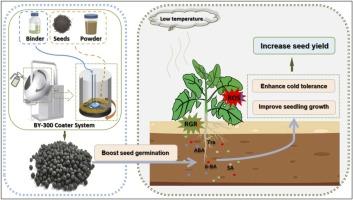Biochar-based pelletized seed enhances the yield of late-sown rapeseed by improving the relative growth rate and cold resistance of seedlings
IF 5.6
1区 农林科学
Q1 AGRICULTURAL ENGINEERING
引用次数: 0
Abstract
The primary factors limiting the yield of late-sown rapeseed are poor germination, restricted seedling growth and weak cold resistance of seedlings. Seed pelletization is known for its convenience of carrying functional agents to improve seed germination and growth, but little research has been reported on late-sown rapeseed pelletization. Therefore, the rapeseed Huayouza-137 was used to pelletize with biochar and functional agents including 6-benzylaminopurine (6-BA), abscisic acid (ABA), salicylic acid (SA) and trehalose (Tre). Then these seeds were subjected to low-temperature incubator tests and 2-years late-sowing field experiment to study the effects on germination, seedling growth, cold resistance and yield. The results showed that: (1) Compared to the control, the highest yield was observed in Tre1 (DSR=1:50), which increased by 9.75 % in 2021–2022 and 5.88 % in 2022–2023. The 6-BA3 (DSR=1:300), ABA3 (DSR=1:150), SA3 (DSR=1:150) increased yield by 2.75 % ∼ 9.01 % in two growing season. (2) The 6-BA3, ABA3, SA3, Tre1 showed significant improvement in emergence and germination and the relative growth rate of seedlings was significantly higher. (3) Compared with TX0, the pelletizing treatments (6-BA3, ABA3, SA3, Tre1) significantly increased osmoregulatory capacity and enzymatic antioxidant capacity, and reduced membrane lipid damage and reactive oxygen species damage in seedlings during overwintering. (4) The redundancy analysis and correlation network analysis revealed the late-sown rapeseed yield was significantly and positively correlated with the relative growth rate and the cold resistance of seedlings during the overwintering. Overall, this study provides a innovative approach to improve late-sown rapeseed yield by biochar-based seed pelletizing.

生物炭颗粒化种子通过提高秧苗的相对生长率和抗寒性来提高晚播油菜籽的产量
限制晚播油菜籽产量的主要因素是发芽率低、幼苗生长受限和幼苗抗寒性弱。种子丸粒化以其携带功能性制剂以提高种子发芽率和生长率的便利性而著称,但有关晚播油菜籽丸粒化的研究却鲜有报道。因此,我们采用 Huayouza-137 油菜籽,用生物炭和功能剂(包括 6-苄基氨基嘌呤 (6-BA)、脱落酸 (ABA)、水杨酸 (SA) 和曲哈糖 (Tre))进行粒化。然后对这些种子进行低温培养箱试验和为期两年的晚播田间试验,研究其对发芽、幼苗生长、抗寒性和产量的影响。结果表明(1)与对照相比,Tre1(DSR=1:50)产量最高,2021-2022 年增产 9.75%,2022-2023 年增产 5.88%。6-BA3(DSR=1:300)、ABA3(DSR=1:150)、SA3(DSR=1:150)在两个生长季增产 2.75 % ∼ 9.01 %。(2)6-BA3、ABA3、SA3、Tre1 的出苗率和发芽率显著提高,幼苗相对生长率显著提高。(3)与 TX0 相比,颗粒化处理(6-BA3、ABA3、SA3、Tre1)明显提高了秧苗越冬期间的渗透调节能力和酶抗氧化能力,减少了膜脂损伤和活性氧损伤。(4)通过冗余分析和相关网络分析发现,晚播油菜籽产量与越冬期幼苗相对生长速率和抗寒性显著正相关。总之,本研究为通过生物炭制粒提高晚播油菜产量提供了一种创新方法。
本文章由计算机程序翻译,如有差异,请以英文原文为准。
求助全文
约1分钟内获得全文
求助全文
来源期刊

Industrial Crops and Products
农林科学-农业工程
CiteScore
9.50
自引率
8.50%
发文量
1518
审稿时长
43 days
期刊介绍:
Industrial Crops and Products is an International Journal publishing academic and industrial research on industrial (defined as non-food/non-feed) crops and products. Papers concern both crop-oriented and bio-based materials from crops-oriented research, and should be of interest to an international audience, hypothesis driven, and where comparisons are made statistics performed.
 求助内容:
求助内容: 应助结果提醒方式:
应助结果提醒方式:


